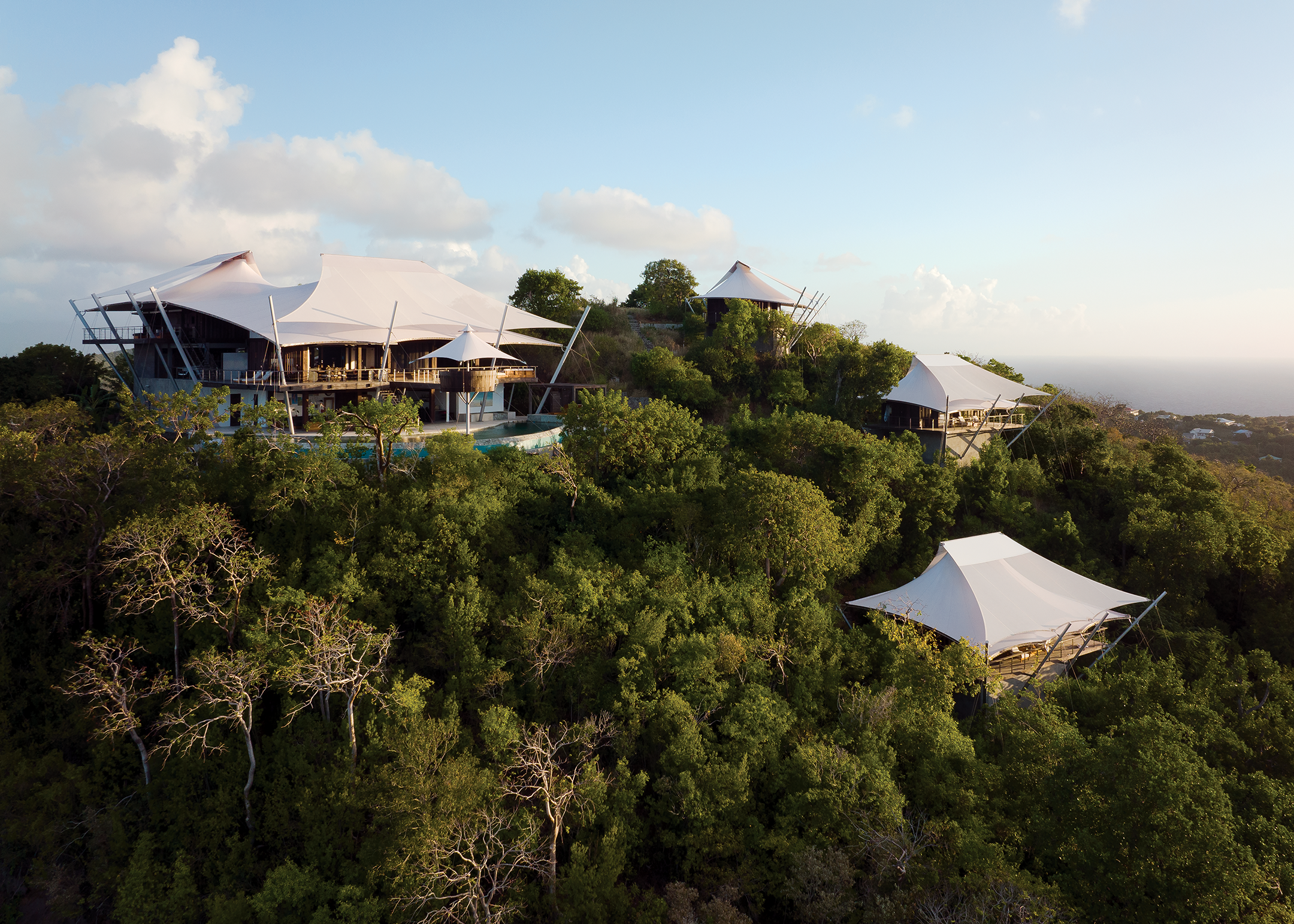
SAIL AWAY, BEQUIA,
ST VINCENT & THE GRENADINES
SHOWCASE | SAIL AWAY, BEQUIA, ST VINCENT & THE GRENADINES
On an island beloved by sailors with a long tradition of boat building, The Sail House is innovative yet entirely appropriate for its context.
Words by Natasha Were. Photography by Kevin Scott.
From a distance, the white, swooping roofs of The Sail House have an almost ethereal appearance, like butterflies hovering over the densely forested hillside. Zoom in though, and the impression changes: the white wings become sails supported by aluminium masts, stretched tight over timber decks, with a gangplank reaching out to a circular crow’s nest.
A seven-year project from concept to completion, this magical hybrid of house and yacht is a feat of imagination, design, engineering, and logistics. Built using sustainable and reclaimed materials and conceived to run almost entirely on renewable energy, it has won multiple awards. Yet for the owners, Mike Wilkie and Nicola Cornwell, building a home had never been part of the plan.
In 2008, the couple had ‘opted out’. They quit their jobs, bought a sailboat and embraced the cruising lifestyle, sailing the Caribbean chain with no destination in mind. So taken were they with simply going wherever the ocean breeze took them that they soon sold their properties, fully committing to a nomadic lifestyle. But the breeze, it seemed, kept blowing them to Bequia, the largest of the Grenadines, a place that felt like stepping back in time.
On an early foray inland, they had seen the sloping two-acre plot of land, 650 feet above sea level, with glorious views down into Admiralty Bay and Friendship Bay and along the island chain. Each time they returned to the island, they would hike up the mountain and admire the land all over again – but for two years, they resisted the urge to purchase it. Once they did though, their innate design instincts kicked in.
OCEAN INSPIRATION
Mike and Nicola had plenty of creative ideas, but it was primarily, their years at sea that informed how they wanted to live on terra firma. “On a boat, you really have to embrace nature rather than closing yourselves off from it,” Nicola observes. “You work with the trade winds, use the shade, and don’t waste precious water or power – so we knew that if we did live on land, we would want to approach it sensitively.”
They found their ideal design partner in California-based architect David Hertz of Studio of Environmental Architecture. A pioneer of sustainable design who has spent the past 40 years innovating to incredible effect – including designing the spectacular Wing House in Malibu, for which the wings and stabilisers of a Boeing 747 were salvaged and repurposed as seemingly floating roofs – they were confident he was up to this ambitious task. The fact he was also a sailor was perhaps the clincher.
THE LAND YACHT CONCEPT
“I had a vision for a house that was like an old sailboat, with the feeling of sails above you, a wooden deck all around you, and a view out over the ocean,” David explains.
The basic configuration was a three-storey, one-bedroom main house with a wraparound infinity pool for Mike and Nicola, three independent guest houses, a caretaker’s cottage, and a workshop scattered across the site. A solar array on the workshop would generate most of their energy, each structure would sit on a concrete slab that would house a cistern, and the roofs would capture enough rainfall to supply all their water needs.
The framework of each building is aluminium – a robust and lightweight material that is not susceptible to termites or mould – and the floors, decks, and sides are continuous hardwood.
Other than on the north side, walls and windows are conspicuous by their absence. Instead, the east and west sides of each structure are composed entirely of vertical louvres, which can be opened completely or individually adjusted to control how much wind or sun enters. There is no air-conditioning at The Sail House: it simply harnesses the trade winds to cool interiors passively.
On the southern sides, which open onto expansive timber decks, bifold doors made of Perspex and aluminium, hoisted via a nautical pulley system, tuck away out of sight overhead (similar to garage doors), merging indoors and out, and ensuring the panoramic views can be enjoyed in their full splendour.
FROM PIER TO FLOORBOARDS
Given the limited choice and availability of construction materials on a seven-square-mile island, David suggested all the components be pre-fabricated and shipped to the island flat-packed.
“Although I try to work with local suppliers, construction materials in Bequia were limited to concrete blocks and metal roofs,” David explains. “Pre-fabricating it meant we could receive all the components – roof, floors and aluminium frame – with all the plumbing and electrics already installed.”
This yacht-esque creation required a considerable amount of high-quality hardwood.
“In Indonesia, Ulin is the local ironwood – a particularly dense wood that is pest and mould-resistant, and so is prized for construction,” Nicola says. “Due to its very slow growth rate, however, ulin can no longer be legally felled, so the only means of acquiring it is to purchase reclaimed wood.”
“Quite early in the design stage,” Mike continues, “the company in Bali that was making the timber components called to say there was an ironwood shipping pier in Borneo slated for demolition. This wasn’t a little wooden jetty. It was a commercial dock – and we bought the whole thing!”
The pier was dismantled, measured, cut, and repurposed as the floorboards, louvres and decks, with many of the dents and scars made by past ships left visible, lending it a weathered patina.
THE ULTIMATE LOOKOUT
Taking the land yacht analogy to its conclusion and borrowing from Frank Lloyd Wright’s principle of compression and expansion, the main door opens into the living area – the kitchen to one side, the living area to the other, and that stunning view directly ahead. Beyond the deck and directly in line with the front door, a wooden gangplank draws one through the house and towards the island-studded horizon. Suspended above the pool, it ends at a barrel-shaped crow’s nest – the ultimate spot to sit and watch approaching squalls or gaze out at the 360-degree views.
ROOFING INNOVATION
The crowning glory of The Sail House is, unarguably, its roof. The high tensile fabric system is typically used for large public buildings – notably Denver Airport and London’s Millennium Dome – where it can span huge spaces without the need for supporting beams.
In this instance, the architect chose it because it allowed for deeper overhangs – and thus more shade and more surface area for rain catchment – than one could create with a conventional roof while being both flexible and wind resistant.
Its swooping form is supported by a series of aluminium masts, which in turn act as conduits to channel rainwater into the cistern. An opening in the centre of the membrane acts as a thermal chimney, allowing rising hot air to escape – with a second membrane covering the opening to prevent rain from entering.
As far as they know, this is the first time such a roofing system has been applied to a domestic design, the owners say, and the whole team is excited about its potential future use for small, pre-fabricated homes.
The Sail House is a multitude of small successes – of sustainable design and self-sufficient living, of recycling and upcycling, of aesthetics and functionality – but it is also much more than that.
Designed, manufactured, and built across continents in a project that brought together German precision engineering, Balinese craftsmanship, and American and European vision and design sensibilities. The Sail House, is a masterpiece of collaboration – and proof beauty, durability and sustainability can coexist harmoniously.











